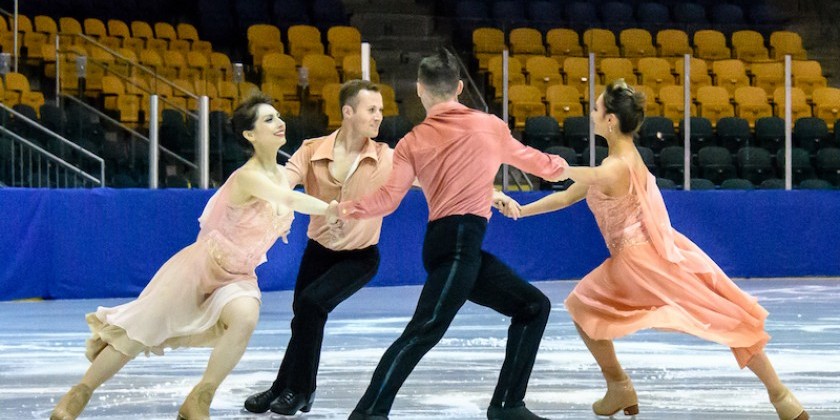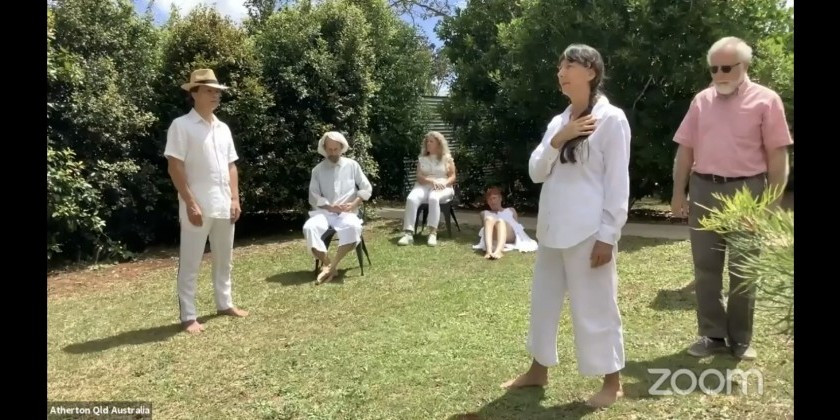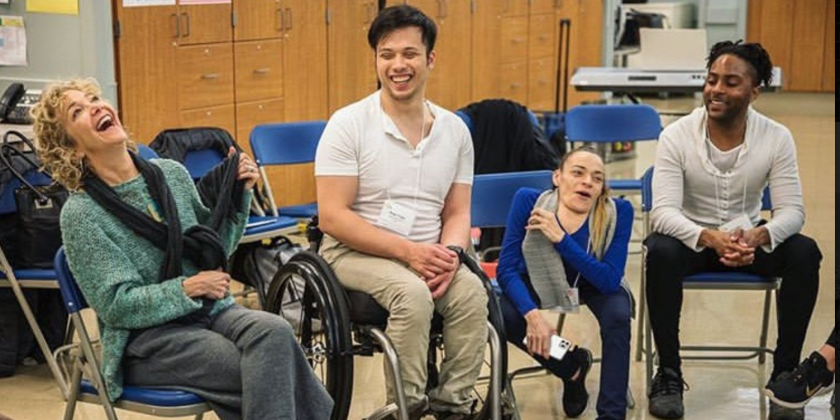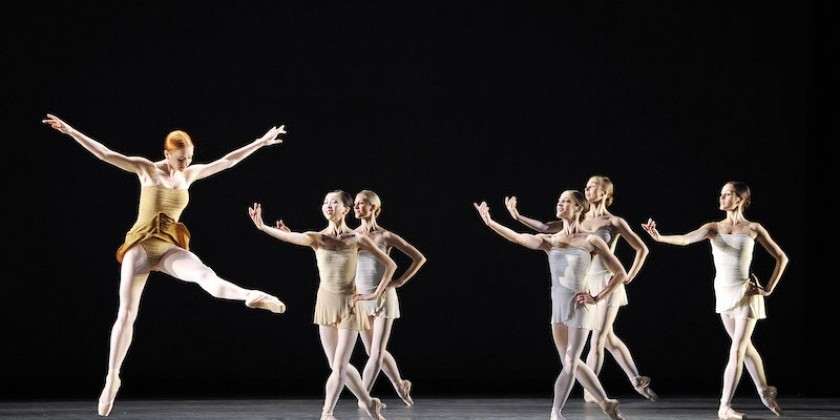Ballet Legend Edward Villella & Acclaimed Ice Dancing Choreographer Douglas Webster Choreograph on Ice Dance International

Ice Dance International
Performance: October 7, 2016
Richard J. Codey Arena
West Orange, NJ
Pictured above: Anastasia Olson, Beata Handra, Joel Dear, and Ian Lorello
This was the New York area debut of the newest enterprise devoted to exploring the possibilities of figure skating as an art form. Ice Dance International emphasizes its kinship with dance, and reminds us that there is far more to skating than the obsessive accumulation of points that is the focus of today's competitive skating. A generous and varied evening of sophisticated ensemble figure skating showed great promise, and transcended the un-theatrical setting of a New Jersey ice rink, where the choreography had to speak for itself, without theatrical lighting or any masking of the bank of yellow seats across from the audience.
Before any skaters took the ice, Douglas Webster – IDI's artistic director and primary choreographer – gave a brief introduction in which he referenced “the lineage of ensemble skating.” He credited John Curry as the source from which IDI (and other troupes committed to that legendary and visionary skater's belief in a company that advances the artistic possibilities of skating) draws inspiration. Curry envisioned – and for a few golden years, managed to sustain – the skating equivalent of a dance company, with its sensibility and priorities far removed from the number-crunching, frenetic and often soulless skating on view in elite competitions these days.

Webster was for many years an integral part of Ice Theatre of New York, eventually becoming Artistic Director. His choreography for ITNY grew in assurance and sophistication over the years. IDI is very much his own venture, founded along with Edward Villella and Dick Button (IDI's Executive Advisors) and Executive Director Debbie Gordon. They have been developing new repertory during intensive three-week residencies in Sun Valley, Idaho.
Villella was brought together with Webster by Button in 2013 to choreograph a piece for ITNY. He applied his ballet sensibility and a desire to communicate the essence of his Balanchine legacy to the skaters. His collaboration with Webster, who could “translate” the choreography into skating vocabulary, resulted in Reveries, a refined, poignantly romantic work for 10 skaters.
Webster and Villella hit if off and wanted to extend their collaboration, so the celebrated former New York City Ballet star (who had recently left Miami City Ballet, which he founded and directed for 25 years) is now an integral part of IDI. Working with Webster, and also testing ideas out with his wife, Linda Carbonetto Villella – a former Canadian national figure skating champion – Villella has created two more works for IDI.

“When Dick Button first asked me to try choreography for ice, I said, 'I really don't know this stuff intimately – but I can bring qualities to all of this.' I work a lot on the upper body – port de bras, eye contact, the offering of a hand,” Villella said by phone the day before the performance. “I figure that's probably my biggest contribution – other than the structure, form, premise, style, and musicality.
“It's wonderful to see if one can transfer from one discipline to the other. From my observation, skaters have in their minds what the technical challenges are. You can almost see it in their faces all the time. What I've been trying to do is get them to relax that sort of approach and get out of the technical pursuit. We all need to have technique. But we also need not to see technique on an ongoing basis – but to see skating, or dancing.”
Villella's Visions of Emeralds: An Homage to Mr. Balanchine is set to the Fauré music Balanchine used for the opening section of Emeralds. As he had for Reveries, Villella intentionally chose music associated with the master, but listened to it with skating's unique gliding and other attributes in mind. “I wanted to see if I could make it logical and practical, to use that as a guiding point. Therefore, I felt I would really be bringing the best of ballet – or the best visions of his intent.”

Villella's homage/translation is an elegantly structured, graciously musical piece that has less of an “old world” feeling than Balanchine's more expansive work. It's deep forest-green costumes are sleek, and the dresses have bodices that evoke the celebrated Karinska designs. (The highly attractive costumes for the entire program were by Alicia Jackson, who finds a lovely individual palette for each work.)
Villella surrounds his central romantic couple (Beata Handra and Joel Dear), who never separate for long, with four women who at times seem to be protective guides, at others serve as devoted followers. There's a gorgeous moment, at the point in the music when the horn seems to issue a fate-like summons, when the couple float to opposite ends of the rink, only to be pulled back to the center, where they circle each other in expansive spread eagles. It's beautifully simple and reverberant.
Villella's other work on the program is a witty winner. He has expanded The Three Smokers, a deft, jiving male trio set to Arie Shaw's recording of Back Bay Shuffle that he had set on Ice Theatre of new York, into a four-part suite, adding more of Shaw's juicy, infectious arrangements. The men meet up with three vibrant ladies and enjoy a night on the town to “Begin the Beguine.” A central couple then floats through a dreamy encounter to “Stardust.” But when the women move on, the men don't appear lost without them – they're fine with each other for company.

In his six works on the program, Webster showcased his inventiveness and ability to utilize the spaciousness of the rink to evoke drama and heighten relationships. Whether it was a duet, trio, octet or a showcase for the full ten-member troupe, Webster's choreography discovers a skating momentum within the music, and even when tricky lifts are included, he never forces its effects. His works have elegance, momentum and variety. They tend to exude a pristine refinement, which is lovely – but maybe one of these days he'll shake things loose a bit.
Spring Awakening, which opened the evening, somehow unearthed a buoyancy and grace in Max Richter's rather heavy-handed reworking of Vivaldi's The Four Seasons. Webster rearranged his cast of eight with kaleidoscopic variety, and included some partnering flourishes that the skaters performed effortlessly – and always with musical sensitivity. I especially admired the graceful flow of Nocturnes, in which three men and three women had resonant individual moments. They seemed to suspend time with their fluent phrasing and made familiar Chopin selections seem new – and ideal for skating.
The Dance Enthusiast Creating Conversations/ See More Conversation in The Day in the Life section
To see more on Doug Webster and Ice Choreography in The Dance Enthusiast click here
Share Your own #AudienceReview of the latest show you've seen for a chance to win a Foodies Delight, Gourmet Olive Oil












